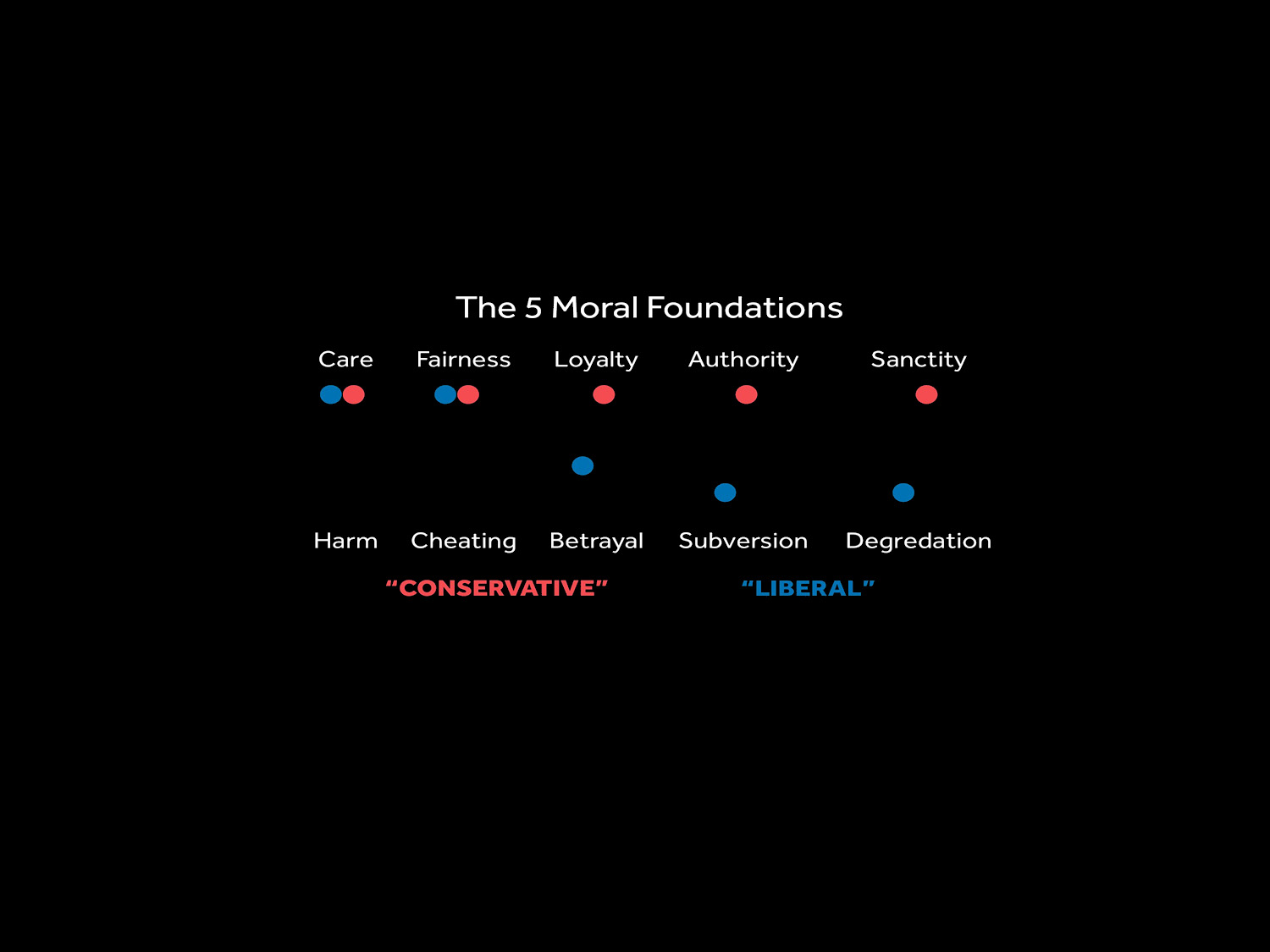We use these axes of the “5 moral foundations” in our workshops to talk about the ways that activists can meet the people they are trying to reach where they are. As artistic activists, the goal is not only to understand, sympathize and be respectful about strongly held beliefs of our “adversaries,” but to create more sophisticated campaigns by giving us insight into those who don’t share our moral beliefs. (See below for how to use this as a tool in your own creative activism).

The 5 Moral Foundations
When we talk about what’s “right and wrong” we often think about violence or cheating. But there’s other aspects to making moral judgements that are less obvious. Researchers have broken down these into five moral frameworks that human beings use to determine what is morally right and wrong. You can learn more below, but here is a rough description of each of the five axes.
1. Care & Harm
Values of kindness, gentleness, and nurturance. We have an ability to care for and be attached to others. We also have the ability to feel and dislike the pain of others.
2. Fairness & Cheating
When we help or are kind to others, we value those who reciprocate. From this generates ideas of justice, rights, and autonomy. It also touches on proportionality – that people take their “fair share”.
3. Loyalty & Betrayal
Humans have an ability to form shifting coalitions and we value those who are loyal to those coalitions. From this comes ideas of patriotism and self-sacrifice for the group.
4. Authority & Subversion
Humans also have an ability to form hierarchical social interactions. This foundation underlies virtues of leadership and followership, including deference to legitimate authority and respect for traditions.
5. Sanctity & Degradation
This foundation was shaped by the psychology of disgust and contamination. It underlies notions of striving to live in an elevated, less carnal, more noble way. It underlies the widespread idea that the body is a temple which can be desecrated by immoral activities and contaminants.
How to Use This as a Tool
You can download the handout and, by yourself or with your group, map out how people understand the issue you’re working on within each of these axes. Some may be harder than others, but brainstorm and see what you come up with. There may be conflicting and counterintuitive stories at play. Then find where there places where the moral narratives might be more widely shared and so could be emphasized in your campaign, or a place where there might be room to shift.
For example, when we have worked on securing rights for people who use drugs, we brainstormed together about how stigma could be changed by using these axes. The sanctity and degradation axis is usually used to condemn people who use drugs for putting dangerous foreign substances into their bodies. This furthers an argument that people who use drugs deserve to suffer. In our campaigns we’d use this sanctity framework to talk about the need to provide clean needles and sterile, supervised spaces so that people using drugs can prevent infection.
This is one example and there are nuances at play here we delve into in our trainings. If you want to know more about how to use these axes on your own projects, and how we use them in combination with exercises to help create effective campaigns, get in touch.
Where can I learn more?
The first place we’d recommend to learn more about Moral Foundations Theory is to check out this episode of the You Are Not So Smart Podcast:
If you want to take a moral foundations survey to see where you land on the chart, you can do that at this site. (It’s actually pretty fun.)
We borrowed heavily from Jonathan Haidt’s “The Righteous Mind: Why Good People Are Divided by Politics and Religion” and his discussion about why we default to tribalism in the bi-polar American Political system. We also used the categories a group of social psychologists laid out in Moral Foundations Theory that are trying to understand “…why morality varies so much across cultures yet still shows so many similarities and recurrent themes.”
If this is useful to you, please donate a few dollars
Help C4AA train and support more activists and artists with your donation. Your contributions make a difference, thank you.




You must be logged in to post a comment.